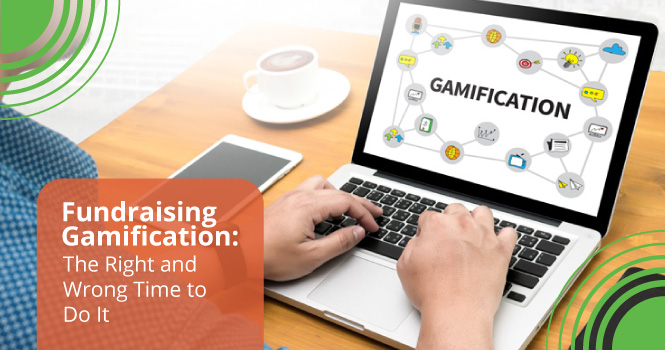-
Software
Compliance Software
Oversee licenses, track renewals, access documents, and more from a single interface.
Software Overview -
Services
Compliance Services
Full service compliance solutions for organizations throughout their entire lifecycles.
Services Overview -
Industries
-
Partner
- Information Center
Fundraising Gamification: The Right and Wrong Time to Do It

When planning a fundraiser of any kind, your nonprofit has lots of options for maximizing your fundraising potential and boosting engagement. One important method is incorporating fundraising gamification into your strategy.
What is fundraising gamification?
Fundraising gamification is a method used to motivate supporters and move them to action. Gamification methods can include fundraising badges, thermometers, leaderboards, and other game-like elements that inspire participation and competition.
Your fundraising software should include technology with gamification features which can help boost your revenue. Showing donors how a fundraiser is performing using a fundraising thermometer, for example, can encourage your supporters to donate and get you to the next milestone.
But for gamification to work, you have to do it right. Believe it or not, there are times when gamification may not be the best option! In this article, we’ll explore:
- The right time to use gamification
- The wrong time to use gamification
- How to make the most of gamification
Are you ready to take a closer look at when to use gamification and how to do it right? Let’s dive in!

The Right Time to Use Gamification
Gamification’s competitive aspects and inspiring visuals make it really useful in lots of fundraising situations! Using it properly in the right kind of fundraising campaign or event can help you engage your participants or guests.
Ask yourself some important questions before investing in fundraising software. One question to ask is whether your platform includes gamification features. Choosing the right software ahead of time will help with campaigns like a peer-to-peer fundraiser, which is a fundraising style that works really well with gamification. Silent auctions are another excellent way to weave in some friendly competition! Other digital fundraising events, like Giving Tuesday, can also benefit from gamification. Let’s take a look at all of these strategies and how you can add gamification elements to make them more engaging.
Peer-to-Peer Fundraising
Peer-to-peer fundraising empowers individuals to raise money on behalf of an organization. A nonprofit recruits its supporters to create their own online fundraising pages and helps them as they work toward a fundraising goal.
Here’s how peer-to-peer fundraising works:
- A nonprofit sets a fundraising goal and uses a peer-to-peer fundraising platform to set up its main campaign page.
- Then, they recruit participants who set up their own individual campaign pages.
- Nonprofit staff provides training and resources for the participants to use while they promote their pages and raise money.
- Participants share their campaign pages on a variety of platforms and encourage their friends and family to support them by contributing to the cause.
- The nonprofit monitors the campaign’s progress and provides ongoing support to the participants.
Peer-to-peer fundraising is a great time to use gamification! Because peer-to-peer fundraising involves lots of individuals raising money for one cause, it’s easy to stir up some friendly competition between your participants. Use a fundraising thermometer to display your progress and create a sense of urgency, and let individual participants or teams display thermometers that track their own progress. Keep your leaderboard updated so your participants know where they stand and who has been raising the most.
If you’re looking for more information on how to start a peer-to-peer fundraising campaign, Qgiv offers a comprehensive guide.
Silent Auctions
Silent auctions typically take place during a larger fundraising event and are intended to be an important part of the event’s overall fundraising total. Generally, nonprofits display multiple items on tables throughout the venue, and guests of the event can walk around and bid on the items that interest them.
During your silent auction, display your fundraising thermometer on a large screen for everyone to see. As people make donations throughout the evening (or make Fund-a-Need or event purchases), you can watch your fundraising thermometer rise in real time. This will encourage donors to continue their support and place their bids. You can also include a live stream of incoming donations and donor names; people love seeing their names on the big screen!
Silent auctions can have a huge impact on your fundraising goal and are great opportunities to try some gamification techniques. To learn more about silent auctions, check out Qgiv’s ultimate guide.
Other Digital Fundraising Events
Other digital fundraising events like Giving Tuesday are excellent times to give gamification a try.
Giving Tuesday occurs on the first Tuesday following Thanksgiving and is an international day of charitable giving at the beginning of the holiday season. Other regional giving days are spaced throughout the year.
During big giving days like Giving Tuesday, it’s important to engage your supporters and draw attention to your cause. You’ll have a lot of competition with other organizations working toward similar causes, so how can you make yours stand out?
Setting a fundraising goal and putting your progress on display with a fundraising thermometer is a great way to encourage more people to get involved and help you reach your goal. This also helps you be transparent about your progress, which is really important to your donors.
Two strategies will make this even more effective for you. One, relate your fundraising goal to a tangible outcome. Asking donors to help you raise, say, $10,000 is much more effective if you tell them what that money will do! Two, be intentional about thanking the people who support you. People like to be recognized for the good they do! Show appreciation for those who contribute; it will encourage others to participate, too!

The Wrong Time to Use Gamification
Gamification is usually an excellent way to inspire your donors to get involved, encourage friendly competition, and bring attention to your cause. But there are some drawbacks to consider! Gamification might not be a good option if:
- You’re not able to put the right amount of time and effort into it. Using gamification takes resources (and the right software!) to create goals and set up a badge or rewards system. If you don’t have sufficient time and energy to devote to this process, it might not be right for you.
- You aren’t careful about where the focus is. The point of using gamification is to focus your donors’ efforts toward a particular cause. Competition can certainly add a fun and engaging element to your campaign, but it’s important that you don’t shift the focus away from the real issues you want to address. You can definitely use gamification tools without losing your focus—you just need to be cognizant of it.
- You’re only using it because it’s “popular.” Be sure you don’t use gamification in your fundraising just because it’s trending in the nonprofit sector. Make sure you’re using gamification in a direct way that will positively influence your results.
Gamification can be an effective and impactful tool in your fundraising strategy, but only if you use it effectively and at the right time. If you think you’re not ready to commit to setting it up or keeping it going, there’s no rush! Take some more time to research and ensure you use it at the right moment for your organization.

Making the Most of It
Gamification takes many forms, but it offers the same result across the board: it makes us feel like we’ve accomplished something. When you incorporate gamification into your fundraising strategy, you’re creating a recipe for engagement.
But gamification can have an even bigger effect. Gamification brings about a sense of community. For example, watching a fundraiser thermometer slowly rise toward its goal lets donors know that others are also involved in the fundraiser. This inspires undecided donors to get involved, too.
Just as you’d want to use the right tools to build your nonprofit’s website, you should use the right tools to work gamification into your fundraisers. In order to make the most of these tools, be sure that you:
- Create goals and use thermometers. Be sure you have an attainable goal so you can build excitement, allow people to track your progress through a thermometer, and encourage donors to give.
- Award badges. Fundraising badges reward active peer-to-peer fundraisers and keep them engaged in the fundraising process. They also motivate other participants to reach the same milestones.
- Use leaderboards. Leaderboards show the top performers during your peer-to-peer fundraiser. Getting public recognition is rewarding for anyone, so a public leaderboard is a great incentive to keep participants engaged.
- Incorporate tangible incentives. Combine the above elements with real-life incentives to boost engagement during your fundraiser. For example, award your donors and participants with ribbons, medals, or even merchandise like custom shirts when they reach certain milestones.
Once you’ve decided to use gamification, be sure you’re making the most of it! There are a ton of ways to keep your supporters engaged and motivated with gamification elements, but it’s important to use these techniques at the right time. Create your goals, award your supporters both digitally and with tangible incentives, and see how much you can raise as a result!
Gamification is a powerful tool you can use during your fundraisers, but it’s essential that you use it correctly. Keep your focus on your cause and invest in fundraising software that will offer the features you need.
If you’re looking for some of the top fundraising software to help move your campaign forward, check out this list. Good luck!
Harbor Compliance is not an accounting or law firm and does not provide tax, financial, or legal advice.

Abby Jarvis is a blogger, marketer, and communications coordinator for Qgiv, an online fundraising service provider. Qgiv offers industry-leading online giving and peer to peer fundraising tools for nonprofit, faith-based, and political organizations of all sizes. When she’s not working at Qgiv, Abby can usually be found writing for local magazines, catching up on her favorite blogs, or binge-watching sci-fi shows on Netflix.





